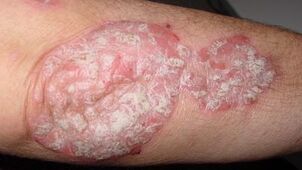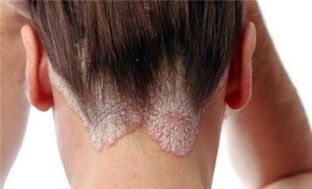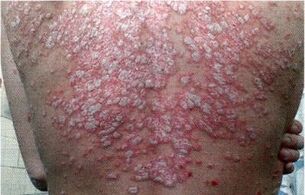
Psoriasis is a long-term chronic skin disease.
Causes of the development of this disease
Psoriasis occurs due to the pathology of skin cells, when the top layer of skin dies in 4-5 days, while usually this interval is several weeks. The cause of the disease is not fully understood, but doctors identify several factors that provoke the disease:
- Hereditary tendencies - this disease manifests itself at a young age, starting from 15 years, and is more often inherited. If one of the parents is diagnosed with psoriasis, the child has more than a 50% chance of getting sick.
- Autoimmune conflict - with this type of disorder, the body's immune cells stop recognizing skin cells as part of the body, begin to attack them as foreign elements.
- Nerve shock - contributes to the release of hormones into the bloodstream, which causes metabolic disorders and provokes the development of disease.
- Disorders of hormonal balance and metabolism.
Psoriasis is not contagious, as no infectious agent can be transmitted.
Psoriasis Symptoms
The main symptoms of this disease are special rashes on the skin, mainly affecting the inner surface of the elbow and knee joints, as well as areas of the skin that often experience friction trauma.
A rash on the side of the scalp and unusual localization may also occur.
Skin rashes appear as spots covered with gray or white scales. Skin rashes on psoriasis have three special features:
- Symptoms of stearin spots:Whiteness scales easily peel off, resembling wax fragments in appearance.
- Terminal film- once the scales are removed, a whitish film covering the surface of the spot can be seen beneath it.
- Bleeding spots- when scratching the spot, the terminal film is removed, the papillae of the skin are damaged, where small droplets of blood stand out.
In the early stages, pale rims form around the papules, there is no exfoliation at this stage. Pale around the spot is the body's vascular reaction to rejection of the epidermis. The disease is accompanied by severe itching of the skin; when scratches, small cracks and bleeding form on the skin. Secondary infections can coalesce, penetrating damaged skin.
In addition to the skin, psoriasis affects the nails, causing fragility on the nail plate, the appearance of transverse patterns and concave areas.
Autoimmune conflict can affect the joints, causing pain such as arthritis, especially in the finger joints.
Types of psoriasis
Psoriasis first occurs in people younger than 30 years, it is a hereditary disease that mainly affects the skin and has a special localization.
Psoriasis type 2 affects people over forty years of age and is not inherited. More often it attacks the nails and scalp, the rash is small and torn. The disease in elderly patients is due to decreased immunity against the background of chronic infectious diseases and improper lifestyle.
Clinical studies have confirmed the link between type 2 psoriasis and alcohol and unhealthy food abuse.
Forms of psoriasis

Psoriasis has several forms of varying severity:
- psoriasis plaque- a special form of papule on the skin, accompanied by itching and flaking.
- The pustular formis characterized by the appearance of blisters, redness of the skin around it, itching and severe burning, is considered a mild form of the disease.
- Erythrodermais characterized by massive skin lesions, accompanied by removal and discharge of large layers of epidermis, very difficult to tolerate, often accompanied by pustular lesions and fungal infections.
Levels of psoriasis
The disease develops in several stages:
- Early stagessignify the onset of the disease, during this period, the more rarely a few pale spots appear, the skin begins to peel off.
- Active levelis accompanied by severe symptoms, excessive skin scales, itching and inflammation.
- Standing phase- indicates remission, exfoliation at this stage practically stops, and instead of pseudoatrophy areas formed spots, pigmentation or pallor.
Diagnostic Psoriasis
To make a diagnosis, you must see a dermatologist. Pathology has a clear clinical picture, confirmed by anamnesis and biopsy of skin elements with further study.
Psoriasis Treatment
Treatment of the disease should be comprehensively obtained, at the same time stopping external symptoms and influencing possible causes of the disease.
Drug therapy
In case of severe illness, steps are taken to reduce the immune system's attacks on its own cells:
- Cytostatics;
- Antihistamines;
- Corticosteroid hormones;
- Enterosorbents and hepatoprotectors are used to restore metabolism.
At the same time, steps are being taken to replenish the body with the necessary vitamins and micronutrients:
- Silicone is one of the important trace elements responsible for hormonal balance and skin health.
- Calcium and vitamin D3 are needed to cure this disease. Set together to increase calcium absorption.
Local solution

For skin protection, external agents are used in the form of ointments and creams:
- Glucocorticoids, which reduce the immune response, also reduce the symptoms of inflammation, relieve itching and swelling of the skin.
- Salicylic acid and herbal products are important for moisturizing the skin and protecting it from secondary infections.
- Topical cytostatics are used only in the active phase of the disease with its severe course.
Procedure
To speed up the healing process, physiological procedures are prescribed:
- Cryotherapy;
- UV irradiation;
- Laser processing.
If necessary, plasmapheresis is performed to clear blood plasma and stabilize cells.
Prevention
If the predisposition of the disease is identified, it is necessary to take a number of preventive measures:
- Follow a healthy lifestyle, quit smoking and alcohol;
- Build daily routines, avoid stress, rationally approach work schedules;
- Follow a diet, avoid excessive amounts of carbohydrates, spices and fatty foods. It is best to avoid preservatives and fast foods;
- Spend enough time outside;
- Use soap and shampoo with a specially selected pH value, do not use hard wipes and towels, dry skin thoroughly after bathing;
- Wear clothing made from natural materials that are not too close to the body;
- Periodically undergo medical examinations, control hormone levels in the blood, and, if necessary, begin initial treatment.
Such measures will help maintain healthy skin and significantly improve quality of life.























